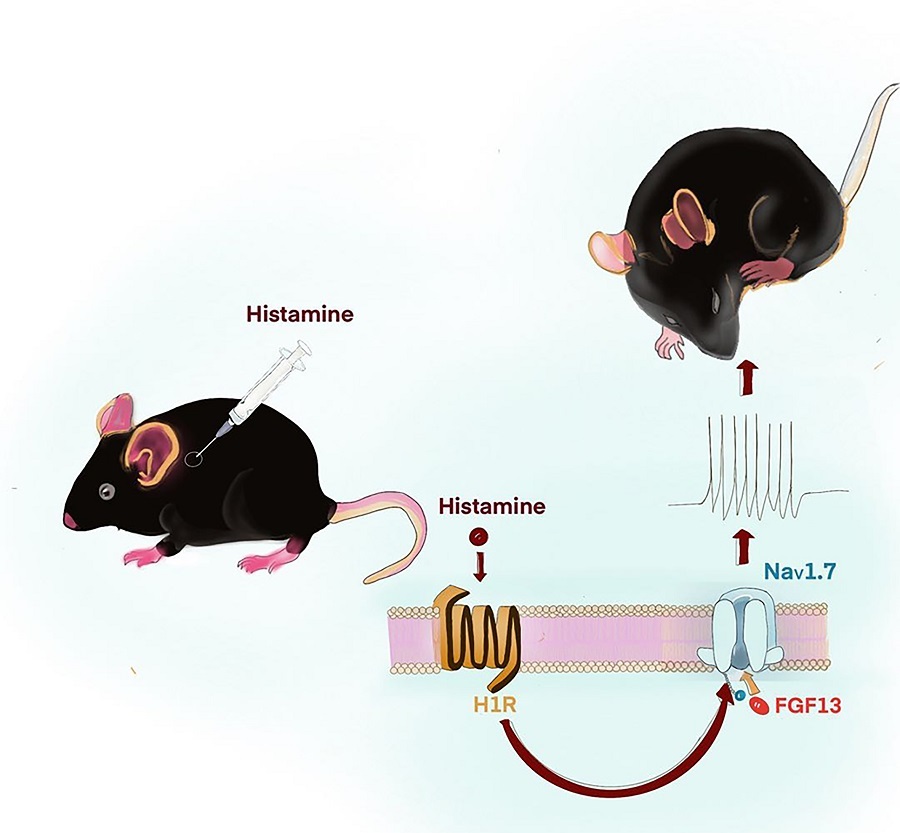Time:2020-12-15
A recent study published in Journal of Neuroscience on Dec. 9, 2020, reveals a novel role of fibroblast growth factor (FGF)13 in mediating itch sensation via the interaction with NaV1.7 in the peripheral nervous system. This work was performed by researchers in Dr. ZHANG Xu’s Lab at the Center for Excellence in Brain Science and Intelligence Technology, Institute of Neuroscience and State Key Laboratory of Neuroscience, and in Dr. BAO Lan’s Lab at State Key Laboratory of Cell Biology, Center for Excellence in Molecular Cell Biology / Shanghai Institute of Biochemistry and Cell Biology, Chinese Academy of Sciences.
FGF13 is expressed abundantly in the neurons of dorsal root ganglion (DRG). Activation of small DRG neurons was found to generate multiple types of somatosensation, including pain and itch. Our previous study examined the functional role of FGF13 in somatosensation using conditional FGF13-deficient mice in small DRG neurons, and these mice lost heat nociception but exhibited normal responses to noxious mechanical stimuli (Yang et al., Neuron, 2017). However, it’s unclear whether FGF13 is involved in the itch sensation.
In this study, researchers found that loss of FGF13 in mouse DRG neurons impaired the histamine-induced scratching behavior. Calcium imaging showed that the percentage of histamine-responsive DRG neurons was largely decreased in FGF13-deficient mice; and consistently, electrophysiological recording showed that histamine failed to evoke action potential firing in most DRG neurons from these mice. Furthermore, overexpression of histamine Type 1 receptor H1R, but not H2R, H3R, nor H4R, increased the percentage of histamine-responsive DRG neurons, and the scratching behavior in FGF13-deficient mice was highly reduced by selective activation of H1R, suggesting that H1R is mainly required for FGF13-mediated neuronal response and scratching behavior induced by histamine. However, overexpression of H1R failed to rescue the histamine-evoked neuronal response in FGF13-deficient mice. Histamine enhanced the FGF13 interaction with NaV1.7. Disruption of this interaction by a membrane-permeable competitive peptide, GST-Flag-NaV1.7CT-TAT, reduced the percentage of histamine-responsive DRG neurons, and impaired the histamine-induced scratching, indicating that the FGF13/NaV1.7 interaction is a key molecular determinant in the histamine-induced itch sensation. Researchers also found that FGF13 was involved in 5-hydroxytryptamine (5-HT) and chloroquine-induced scratching behavior and hapten 1-fluoro-2,4-dinitrobenzene (DNFB)-induced chronic itch.
This work was completed by Dr. DONG Fei with the help of Dr. SHI Haixiang, Dr. YANG Liu, XUE Huaqing, Dr. WEI Manyi and Dr. ZHONG Yanqing under the supervision of Profs. ZHANG Xu and BAO Lan. Prof. SUN Yangang at the Center for Excellence in Brain Science and Intelligence Technology of the Chinese Academy of Sciences and Dr. HAN Qingjian at Institutes of Brain Science, Fudan University also gave generous help. It was funded by National Natural Science Foundation of China, Chinese Academy of Sciences, Science and Technology Commission of Shanghai Municipality, and Chinese Academy of Medical Sciences.

Figure 1 Histamine activates small DRG neurons that express H1R. In the presence of FGF13, activation of H1R leads to subsequent activation of NaV1.7, AP firing, and scratching behavior. (Image by CEBSIT)
AUTHOR CONTACT:
ZHANG Xu
Institute of Neuroscience, CAS Key Laboratory of Primate Neurobiology, Center for Excellence in Brain Science and Intelligence Technology of the Chinese Academy of Sciences
E-mail: xu.zhang@ion.ac.cn
 附件下载:
附件下载: